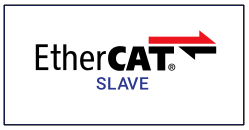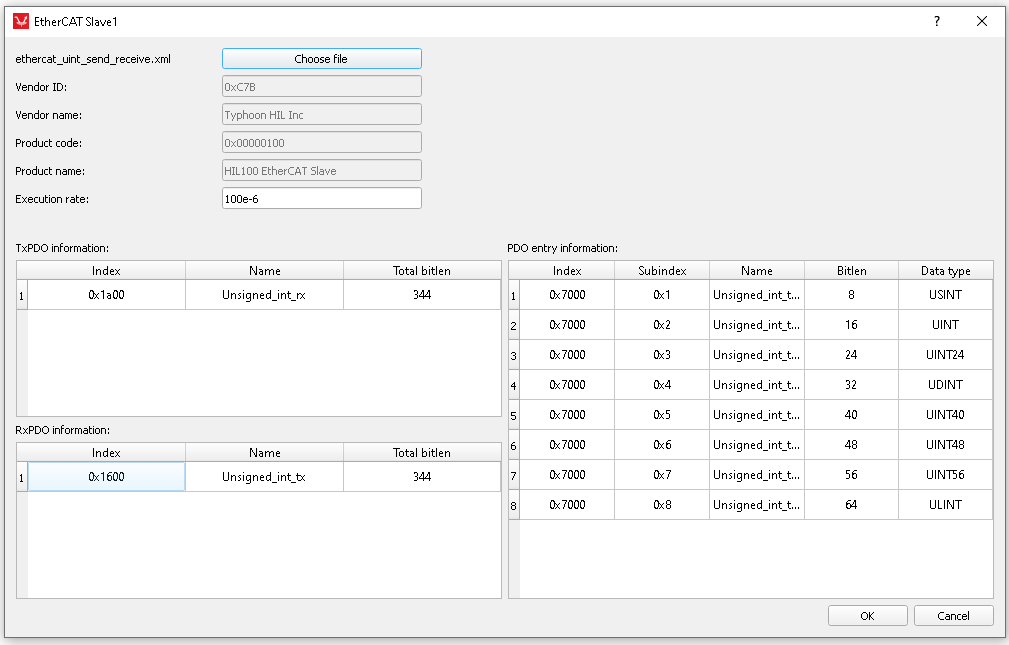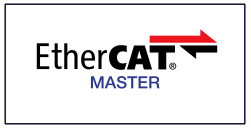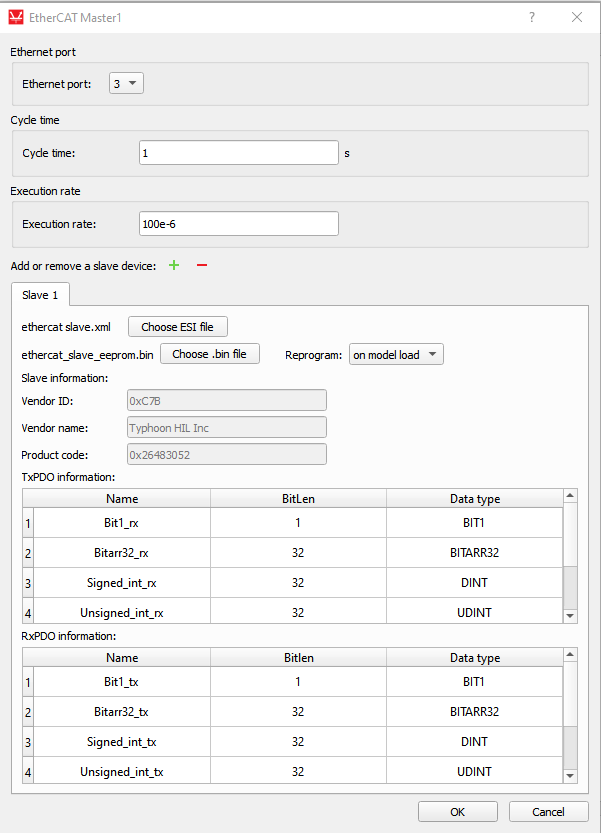EtherCAT Protocol
Description of the EtherCAT protocol implementation in the Typhoon HIL toolchain.
Introduction to EtherCAT protocol
EtherCAT (Ethernet for Control Automation Technology) is an Ethernet-based industrial fieldbus protocol, invented by Beckhoff Automation. The protocol is specifically designed to apply an Ethernet structure for automation applications requiring short data update (cycle) times with low communication jitter and reduced hardware costs.
EtherCAT is a master/slave protocol, which means that there is one master device (implemented completely in the software) and multiple slave devices (implemented in the hardware) connected to a network. Every cycle, the master device sends one standard Ethernet frame which encapsulates multiple EtherCAT datagrams. EtherCAT datagrams address a specific part of the EtherCAT process image (up to 4 GB in size), in which every slave device is assigned one or more addresses. This means that one Ethernet frame sent by a master device contains process data for every slave device in the network. Each slave device reads and writes data from the frame while the frame passes through the device, which is extremely useful for real-time communication. This also eliminates the need for higher level protocol stacks, such as TCP/IP and UDP/IP, because EtherCAT datagrams reach only as high as the second layer (data link) of the ISO/OSI reference model.
Besides this cyclic process data communication, additional acyclic communication profiles have been established, including CanOPEN over EtherCAT (CoE), Ethernet over EtherCAT (EoE) and File Access over EtherCAT (FoE). It is important to note that Typhoon HIL EtherCAT slave and master devices currently do not support any acyclic communication profiles.
The EtherCAT slave device can be configured by the master device using an ESI configuration file, which is essentialy an XML document containing all the information needed for properly setting up a slave device for communication. EtherCAT Slave Configuration decribes the ESI file template designed for use with Typhoon HIL EtherCAT slave devices.
EtherCAT Slave Device hardware
Every EtherCAT compatible Typhoon HIL device is equipped with the Microchip LAN9252 EtherCAT slave hardware. The Microchip LAN9252 comes with three fieldbus memory management units (FMMUs) and four SyncManagers. It contains 4 kB of data process RAM (DPRAM), which is used for storing process data. Two Ethernet ports can be used for interfacing with the master device and another slave device (or two other slave devices).
EtherCAT slave device is compatible with the following Typhoon HIL devices: HIL506 and HIL606.
EtherCAT Slave Device Component
The EtherCAT Slave Device component implements EtherCAT slave functionality. It can be configured by importing an ESI file in the component properties. The component then parses the imported configuration file and displays the details of the process data.
| Component | Component dialog window |
|---|---|

EtherCAT Slave |
 |
Basic slave information (Vendor ID, Vendor name, Product code and Product name) is displayed directly below the Choose file widget. TxPDO information and RxPDO information tables list the Transmit Process Data Objects (PDOs) and Receive PDOs, respectively, as they are defined in the ESI file. By clicking on the PDO item in the TxPDO information or RxPDO information table, the PDO entry information table gets populated with the PDO's entries, as defined in the ESI file. The dialog window serves purely as a display, and as such does not allow any PDO modifications. All such modifications should be done in the ESI configuration file.
After clicking the OK button, defined RxPdo and TxPdo entries are translated into corresponding output and input terminals in the EtherCAT Slave component, with entries' names as the names of the terminals. It is strongly recommended to give unique names to the PDO entries, in order to differentiate the terminals of the EtherCAT Slave component.
EtherCAT Slave Configuration
<EtherCATInfo> - mandatory
<InfoReference> - forbidden
<Vendor> - mandatory
<Id> - mandatory
<Name> - mandatory
<Descriptions>
<Groups> - mandatory
<Group> - mandatory
<Devices> - mandatory
<Device> - mandatory
@Invisible - forbidden
@Physics - fixed - "YY"
<Type> - mandatory
<Name> - mandatory
<GroupType> - mandatory
<Profile> - ignored
<Fmmu> - fixed - Outputs
<Fmmu> - fixed - Inputs
<Sm> - fixed - MBoxOut
@ControlByte - mandatory
@DefaultSize - mandatory
@Enable - fixed - "1"
@StartAddress - mandatory
<Sm> - fixed - MBoxIn
@ControlByte - mandatory
@DefaultSize - mandatory
@Enable - fixed - "1"
@StartAddress - mandatory
<Sm> - fixed - Outputs
@ControlByte - mandatory
@Enable - fixed - "1"
@StartAddress - fixed - in range - 0x1000 - 0x1FFF
<Sm> - fixed - Inputs
@ControlByte - mandatory
@Enable - fixed - "1"
@StartAddress - fixed - in range - 0x1000 - 0x1FFF
<RxPdo> - mandatory (at least one)
@Fixed - fixed - "true"
@Mandatory - fixed - "true"
@Virtual - forbidden
@OverwrittenByModule - forbidden
@SRA_Parameter - forbidden
<Index> - fixed - in range - 0x1600 - 0x17FF
<Name> - mandatory
<Entry>
<Index> - fixed - in range - 0x6000 - 0x9FFF
<SubIndex> - fixed - in range - 0x01 - 0xFF
<Name> - mandatory
<BitLen> - mandatory
<DataType> - mandatory
<DependOnSlot> - forbidden
<DependOnSlotGroup> - forbidden
<TxPdo> - mandatory (at least one)
@Fixed - fixed - "true"
@Mandatory - fixed - "true"
@Virtual - forbidden
@OverwrittenByModule - forbidden
@SRA_Parameter - forbidden
<Index> - fixed - in range - 0x1A00 - 0x1BFF
<Name> - mandatory
<Entry>
<Index> - fixed - in range - 0x6000 - 0x9FFF
<SubIndex> - fixed - in range - 0x01 - 0xFF
<Name> - mandatory
<BitLen> - mandatory
<DataType> - mandatory
<DependOnSlot> - forbidden
<DependOnSlotGroup> - forbidden
<Mailbox> - forbidden
<Slots> - forbidden
<Eeprom> - mandatory
<ByteSize> - fixed - 2048
<ConfigData> - fixed - first two bytes - 80
<Modules> - forbidden SyncManagers
In order for the Typhoon HIL EtherCAT slave device to work properly, all four SyncManagers must be configured as described previously. MBoxOut and MBoxIn SyncManagers should have non-zero default sizes. None of the SyncManagers' memory regions should overlap. Keep in mind that the memory regions of Outputs and Inputs SyncManagers are triple the size of their assigned PDOs. This is needed in order to keep the memory regions synchronized. Lastly, the total size of the SyncManagers' memory regions should not exceed the total size of DPRAM (4kB).
Process Data Objects
RxPdo and TxPdo elements of the ESI file represent a single Process Data Object which takes part in data exchange between the master and slave devices. Data transmitted from the slave device to the master device is described by TxPdo elements, while RxPdo elements describe data transmitted from the master device to the slave device. Each PDO must be defined by a unique index and a (not necessarily unique) name. RxPdo indexes must belong to the 0x1600 - 0x17FF range, while TxPdo indexes must belog to the 0x1A00 - 0x1BFF range. Since Typhoon HIL EtherCAT slave devices do not support dynamic PDO configuration, PDO elements should have Fixed and Mandatory attributes set to "true". Sm attribute of the PDO element should be set to the index of the corresponding SyncManager (Outputs SyncManager corresponds to RxPdo elements, while Inputs SyncManager corresponds to TxPdo elements).
Each PDO element consists of zero or more Entry elements which describe a single variable partaking in the process data communication. Entries are uniquely defined by an index and a subindex. Data which they carry is described by its bitlength and data type. Data types described by the EtherCAT protocol are listed in Table 2. Note that the Typhoon HIL devices do not support data types longer than 32-bits, which means that all EtherCAT Base Data types longer than this will be truncated.
| Name | Description | Bit Size | Range |
|---|---|---|---|
| BOOL | Boolean | 1 | |
| BIT1 | 1 Bit String | 1 | |
| BIT2 | 2 Bit String | 2 | |
| BIT3 | 3 Bit String | 3 | |
| BIT4 | 4 Bit String | 4 | |
| BIT5 | 5 Bit String | 5 | |
| BIT6 | 6 Bit String | 6 | |
| BIT7 | 7 Bit String | 7 | |
| BIT8 | 8 Bit String | 8 | |
| BITARR8 | 8 Individual Bits | 8 | |
| BITARR16 | 16 Individual Bits | 16 | |
| BITARR32 | 32 Individual bits | 32 | |
| SINT | Short Integer | 8 | -128 to 127 |
| INT | Integer | 16 | -32.768 to 32.767 |
| INT24 | 24-Bit Integer | 24 | -223 to 223 - 1 |
| DINT | Double Integer | 32 | -231 to 231 - 1 |
| INT40 | 40-Bit Integer | 40 | -239 to 239 - 1 |
| INT48 | 48-Bit Integer | 48 | -247 to 247 - 1 |
| INT56 | 56-Bit Integer | 56 | -255 to 255 - 1 |
| LINT | Long Integer | 64 | -263 to 263 - 1 |
| USINT | Unsigned Short Integer | 8 | 0 to 255 |
| UINT | Unsigned Integer | 16 | 0 to 65.535 |
| UINT24 | Unsigned 24-Bit Integer | 24 | 0 to 224 - 1 |
| UDINT | Unsigned Double Integer | 32 | 0 to 232 - 1 |
| UINT40 | Unsigned 40-Bit Integer | 40 | 0 to 240 - 1 |
| UINT48 | Unsigned 48-Bit Integer | 48 | 0 to 248 - 1 |
| UINT56 | Unsigned 56-Bit Integer | 56 | 0 to 256 - 1 |
| ULINT | Unsigned Long Integer | 64 | 0 to 264 - 1 |
| REAL | Floating Point | 32 | |
| LREAL | Long Float | 64 |
Due to software limitations, there should be at least one of each RxPdo and TxPdo elements of non-zero bit length in the ESI file in order for the Typhoon HIL EtherCAT slave device to work properly (even if the defined PDOs are not used).
EEPROM
<ConfigData> subelement of the <Eeprom> element of the ESI file allows for specifying the EEPROM configuration data. Since the Typhoon HIL EtherCAT slave device uses SPI microcontroller interface, the first two bytes of the EEPROM configuration data should be set to 80.
Example of ESI configuration file
The following example shows a process data configuration in which one 32-bit entry of DINT data type is sent from the slave device to the master device, and another entry of the same type is sent in the opposite direction. Adding or removing PDOs and their entries can be done freely, as long as the total size of the PDOs does not exceed the limitations of the DPRAM (described in the SyncManagers paragraph).
<?xml version="1.0"?>
<EtherCATInfo xmlns:xsi="http://www.w3.org/2001/XMLSchema-instance" xsi:noNamespaceSchemaLocation="EtherCATInfo.xsd" Version="1.6">
<Vendor>
<Id>#xC7B</Id>
<Name>Typhoon HIL Inc</Name>
</Vendor>
<Descriptions>
<Groups>
<Group>
<Type>HIL606 Slaves</Type>
<Name LcId="1033">HIL606 Slaves</Name>
</Group>
</Groups>
<Devices>
<Device Physics="YY">
<Type ProductCode="#x00000100" RevisionNo="#x1">HIL606 EtherCAT Slave</Type>
<Name LcId="1033">HIL606 EtherCAT Slave</Name>
<GroupType>HIL100 Slaves</GroupType>
<Fmmu>Outputs</Fmmu>
<Fmmu>Inputs</Fmmu>
<Sm ControlByte="#x26" DefaultSize="128" Enable="1" StartAddress="#x1000">MBoxOut</Sm>
<Sm ControlByte="#x22" DefaultSize="128" Enable="1" StartAddress="#x1080">MBoxIn</Sm>
<Sm ControlByte="#x24" Enable="1" StartAddress="#x1100">Outputs</Sm>
<Sm ControlByte="#x20" Enable="1" StartAddress="#x1300">Inputs</Sm>
<RxPdo Fixed="true" Mandatory="true" Sm="2">
<Index>#x1600</Index>
<Name>TestRxVars</Name>
<Entry>
<Index>#x7000</Index>
<SubIndex>#x1</SubIndex>
<BitLen>32</BitLen>
<Name>TestRxVar</Name>
<DataType>DINT</DataType>
</Entry>
</RxPdo>
<TxPdo Fixed="true" Mandatory="true" Sm="3">
<Index>#x1A00</Index>
<Name>TestTxVars</Name>
<Entry>
<Index>#x6000</Index>
<SubIndex>#x1</SubIndex>
<BitLen>32</BitLen>
<Name>TestTxVar</Name>
<DataType>DINT</DataType>
</Entry>
</TxPdo>
<Eeprom>
<ByteSize>2048</ByteSize>
<ConfigData>8002000000000000</ConfigData>
<BootStrap>0010800080108000</BootStrap>
</Eeprom>
</Device>
</Devices>
</Descriptions>
</EtherCATInfo>
EtherCAT Master Component
The EtherCAT Master Device component implements EtherCAT master functionality. This component enables selection of an Ethernet port on the HIL device through which data will be exchanged with slave devices. Additionally, it is possible to adjust the cycle time within a range from 0.2 ms to 3600 s. The cycle time parameter determines how often, in seconds, the master initiates the sending of a single standard Ethernet frame containing multiple EtherCAT datagrams.
By clicking the plus sign, it's possible to add an arbitrary number of slave devices, where the number of slave devices should match the number of slave devices currently on the network. Information about each slave device is displayed within its respective tab, where the tab order corresponds to the physical order of slave devices on the network (the first tab signifies that this slave device is the first on the network). Clicking the minus sign removes the currently selected tab (slave device).
For each slave device, importing its ESI file is required. The structure of the ESI file must comply with the following:
- The file must comply with the EtherCAT protocol rules
- The Fixed attribute of the TxPDO and RxPDO elements is mandatory. The Fixed attribute should have a value of 1 to indicate that the PDO content is not configurable
The master component then parses the imported ESI file and displays information fields of the slave device such as Vendor ID, Vendor name, Product code, RxPdo, and TxPdo entries.
EtherCAT master component has the capability to reprogram slave devices. In that case, it is necessary to import the binary file and select the on model load option from the Reprogram combo box. Generally, importing the binary file of the slave device is not necessary for the operation of the master component unless the slave device needs to be reprogrammed.
It is possible to change name of a slave device by double-clicking on the tab name. Unique names for slave devices are necessary. Their default names are Slave 1, Slave 2, and so on.
After clicking the OK button, parsed RxPdo and TxPdo entries for each slave are translated into corresponding input and output terminals in the EtherCAT Master component. It is strongly recommended to assign unique names to the PDO entries for each slave in order to differentiate the terminals of the EtherCAT Master component corresponding to that slave.
| Component | Component dialog window |
|---|---|
 |
 |
Example of ESI configuration file with padding bits
In order to avoid unexpected errors during configuration and usage of the Typhoon HIL EtherCAT master component, it is necessary to add padding bits for each PDO entry that has a bit count different from 8, 16, 32, or 64 bits. This requirement applies to the ESI file of every slave device. An example of an ESI file with padding bits is given below. Padding bits are defined within the <Entry> tag, with <Index> and<SubIndex> values set to 0, while the <BitLen> is set to a value such that the total size of the corresponding PDO entry is 8, 16, 32, or 64 bits.
<?xml version="1.0"?>
<EtherCATInfo xmlns:xsi="http://www.w3.org/2001/XMLSchema-instance" xsi:noNamespaceSchemaLocation="EtherCATInfo.xsd" Version="1.6">
<Vendor>
<Id>#xC7B</Id>
<Name>Typhoon HIL Inc</Name>
<ImageData16x14>424DF8010000000000003600000028000000100000000E0000000100100000000000C2010000120B0000120B00000000000000000000FF7FFF7FFF7FFF7FFF7FFF7FFF7FFF7FFF7FFF7FFF7FFF7FFF7FFF7FFF7FFF7FFF7FFF7FFF7FFF7F397B8C75C6748474A5744A75947AFF7FFF7FFF7FFF7FFF7FFF7FFF7FFF7F8B7521746374847420706374837441746374FF7FFF7FFF7FFF7FFF7FFF7FFF7F00708374A47400709C7FA47463744274E674FF7FFF7FFF7FFF7FFF7FFF7FFF7FFF7F00702074CD79FF7FFF7F00740070FF7FFF7FFF7FFF7FFF7FFF7F5A7FFF7FFF7F947A0070FF7FFF7FFF7F0070D67AFF7FFF7FD67AFF7FFF7FFF7F0070FF7FFF7F00709C7FFF7FFF7FCD796274FF7FFF7FFF7F00705A7FFF7FFF7F6274E774AD754975FF7FFF7FFF7F0070FF7FFF7FFF7FA5740875FF7FFF7FFF7F497541740070FF7FFF7FFF7F0070187FFF7FFF7FF77A2174FF7FFF7FFF7FFF7F937A217400709C7FFF7F317A0070C674FF7FFF7F00705A7FFF7FFF7FFF7FFF7FFF7F087541740070397B0070A4742170EF790775297DFF7FFF7FFF7FFF7FFF7FFF7FFF7FAC79007000708474A47484742170A57CFF7F7B6FFF7FFF7FFF7FFF7FFF7FFF7FFF7F397F8B75C6748474C574AC75FF7FD6561863FF7FFF7FFF7FFF7FFF7FFF7FFF7FFF7FFF7FFF7FFF7FFF7FFF7FFF7FFF7FFF7FFF7FFF7FFF7F0000</ImageData16x14>
</Vendor>
<Descriptions>
<Groups>
<Group>
<Type>HIL100 Slaves</Type>
<Name LcId="1033">HIL100 Slaves</Name>
<ImageData16x14>424DF8010000000000003600000028000000100000000E0000000100100000000000C2010000120B0000120B00000000000000000000FF7FFF7FFF7FFF7FFF7FFF7FFF7FFF7FFF7FFF7FFF7FFF7FFF7FFF7FFF7FFF7FFF7FFF7FFF7FFF7F397B8C75C6748474A5744A75947AFF7FFF7FFF7FFF7FFF7FFF7FFF7FFF7F8B7521746374847420706374837441746374FF7FFF7FFF7FFF7FFF7FFF7FFF7F00708374A47400709C7FA47463744274E674FF7FFF7FFF7FFF7FFF7FFF7FFF7FFF7F00702074CD79FF7FFF7F00740070FF7FFF7FFF7FFF7FFF7FFF7F5A7FFF7FFF7F947A0070FF7FFF7FFF7F0070D67AFF7FFF7FD67AFF7FFF7FFF7F0070FF7FFF7F00709C7FFF7FFF7FCD796274FF7FFF7FFF7F00705A7FFF7FFF7F6274E774AD754975FF7FFF7FFF7F0070FF7FFF7FFF7FA5740875FF7FFF7FFF7F497541740070FF7FFF7FFF7F0070187FFF7FFF7FF77A2174FF7FFF7FFF7FFF7F937A217400709C7FFF7F317A0070C674FF7FFF7F00705A7FFF7FFF7FFF7FFF7FFF7F087541740070397B0070A4742170EF790775297DFF7FFF7FFF7FFF7FFF7FFF7FFF7FAC79007000708474A47484742170A57CFF7F7B6FFF7FFF7FFF7FFF7FFF7FFF7FFF7F397F8B75C6748474C574AC75FF7FD6561863FF7FFF7FFF7FFF7FFF7FFF7FFF7FFF7FFF7FFF7FFF7FFF7FFF7FFF7FFF7FFF7FFF7FFF7FFF7F0000</ImageData16x14>
</Group>
</Groups>
<Devices>
<Device Physics="YY">
<Type ProductCode="#x00000100" RevisionNo="#x1">HIL100 EtherCAT Slave</Type>
<Name LcId="1033">HIL100 EtherCAT Slave</Name>
<GroupType>HIL100 Slaves</GroupType>
<Fmmu>Outputs</Fmmu>
<Fmmu>Inputs</Fmmu>
<Sm ControlByte="#x26" DefaultSize="128" Enable="1" StartAddress="#x1000">MBoxOut</Sm>
<Sm ControlByte="#x22" DefaultSize="128" Enable="1" StartAddress="#x1080">MBoxIn</Sm>
<Sm ControlByte="#x24" Enable="1" StartAddress="#x1100">Outputs</Sm>
<Sm ControlByte="#x20" Enable="1" StartAddress="#x1300">Inputs</Sm>
<RxPdo Fixed="true" Mandatory="true" Sm="2">
<Index>#x1600</Index>
<Name>Signed_int_tx</Name>
<Entry>
<Index>#x7000</Index>
<SubIndex>#x1</SubIndex>
<BitLen>8</BitLen>
<Name>Signed_int_tx_1</Name>
<DataType>SINT</DataType>
</Entry>
<Entry>
<Index>#x7000</Index>
<SubIndex>#x2</SubIndex>
<BitLen>24</BitLen>
<Name>Signed_int_tx_2</Name>
<DataType>INT24</DataType>
</Entry>
<Entry>
<Index>#x0</Index>
<SubIndex>#x0</SubIndex>
<BitLen>8</BitLen>
</Entry>
<Entry>
<Index>#x7000</Index>
<SubIndex>#x3</SubIndex>
<BitLen>40</BitLen>
<Name>Signed_int_tx_3</Name>
<DataType>INT40</DataType>
</Entry>
<Entry>
<Index>#x0</Index>
<SubIndex>#x0</SubIndex>
<BitLen>24</BitLen>
</Entry>
</RxPdo>
<TxPdo Fixed="true" Mandatory="true" Sm="3">
<Index>#x1A00</Index>
<Name>Signed_int_rx</Name>
<Entry>
<Index>#x6000</Index>
<SubIndex>#x1</SubIndex>
<BitLen>56</BitLen>
<Name>Signed_int_rx_1</Name>
<DataType>INT56</DataType>
</Entry>
<Entry>
<Index>#x0</Index>
<SubIndex>#x0</SubIndex>
<BitLen>8</BitLen>
</Entry>
</TxPdo>
<Eeprom>
<ByteSize>2048</ByteSize>
<ConfigData>8002000000000000</ConfigData>
<BootStrap>0010800080108000</BootStrap>
</Eeprom>
<ImageData16x14>424DF8010000000000003600000028000000100000000E0000000100100000000000C2010000120B0000120B00000000000000000000FF7FFF7FFF7FFF7FFF7FFF7FFF7FFF7FFF7FFF7FFF7FFF7FFF7FFF7FFF7FFF7FFF7FFF7FFF7FFF7F397B8C75C6748474A5744A75947AFF7FFF7FFF7FFF7FFF7FFF7FFF7FFF7F8B7521746374847420706374837441746374FF7FFF7FFF7FFF7FFF7FFF7FFF7F00708374A47400709C7FA47463744274E674FF7FFF7FFF7FFF7FFF7FFF7FFF7FFF7F00702074CD79FF7FFF7F00740070FF7FFF7FFF7FFF7FFF7FFF7F5A7FFF7FFF7F947A0070FF7FFF7FFF7F0070D67AFF7FFF7FD67AFF7FFF7FFF7F0070FF7FFF7F00709C7FFF7FFF7FCD796274FF7FFF7FFF7F00705A7FFF7FFF7F6274E774AD754975FF7FFF7FFF7F0070FF7FFF7FFF7FA5740875FF7FFF7FFF7F497541740070FF7FFF7FFF7F0070187FFF7FFF7FF77A2174FF7FFF7FFF7FFF7F937A217400709C7FFF7F317A0070C674FF7FFF7F00705A7FFF7FFF7FFF7FFF7FFF7F087541740070397B0070A4742170EF790775297DFF7FFF7FFF7FFF7FFF7FFF7FFF7FAC79007000708474A47484742170A57CFF7F7B6FFF7FFF7FFF7FFF7FFF7FFF7FFF7F397F8B75C6748474C574AC75FF7FD6561863FF7FFF7FFF7FFF7FFF7FFF7FFF7FFF7FFF7FFF7FFF7FFF7FFF7FFF7FFF7FFF7FFF7FFF7FFF7F0000</ImageData16x14>
</Device>
</Devices>
</Descriptions>
</EtherCATInfo>In this example of an ESI file, one 8-bit entry of SINT data type is defined, as well as one 24-bit entry of INT24 data type, for which it is necessary to define a padding PDO entry with a bit length set to 8. Additionally, one 40-bit entry of INT40 data type is defined for which it is necessary to define 24 padding bits. These three entries, excluding padding PDO entries, are defined within the RxPDO object, meaning they participate in the transmission of data sent from the master device to the slave. In the opposite direction, one 56-bit entry of INT56 data type is defined for which it is necessary to define a padding PDO entry with a bit length set to 8.
The EtherCAT Master component is compatible with the following Typhoon HIL devices: HIL101, HIL404, HIL506, and HIL606.
Virtual HIL support
Virtual HIL currently does not support this protocol. When using a non-real-time environment (e.g. when running the model on a local computer), inputs to this component will be discarded and outputs from this component will be zeroed.